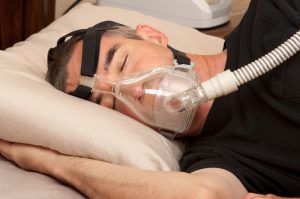 If your doctor has ordered you to wear a CPAP machine to help with sleep apnea, you may wonder how you will ever get a good night’s rest with this contraption on your face. Many people who suffer from sleep apnea wear their mask nightly and enjoy the best sleep of their lives. By following the tips below, you too can sleep soundly with your mask on.
If your doctor has ordered you to wear a CPAP machine to help with sleep apnea, you may wonder how you will ever get a good night’s rest with this contraption on your face. Many people who suffer from sleep apnea wear their mask nightly and enjoy the best sleep of their lives. By following the tips below, you too can sleep soundly with your mask on.
Adjust to Fit
One of the biggest problems that people have with the machine is that the mask is too tight, causing discomfort. The head strap can often compress the unit, making it hard for you to rest. The best way to solve this problem is to make sure that the straps are properly fitted.
If the straps are too loose, the mask can slip off your face, blowing air into your eyes. This is also uncomfortable and will interrupt your sleep. Make sure the mask feels comfortable before you lie down. Adjust the straps to make sure the fit is secure but not too tight.
Adjust the Pressure
When you first received your mask, your technician should have adjusted the air pressure to your doctor’s prescription. This would have given you the right amount of air flowing through the machine. Over time, the pressure may weaken if it is not adjusted. This can make it harder for you to breathe, interrupting your sleep time.
If the pressure of the air is difficult to get used to, many machines have a “ramp” function that allows you to gradually increase the pressure at increments that are practically imperceptible. The full force of the air doesn’t come about until you are already asleep.
Dry Nose and Mouth
Some people find that the air circulating through the CPAP can cause a dry nose and mouth. The easiest way to deal with this problem is to use a humidifier in your bedroom. You can also use a nasal spray to moisturize your nasal passages, making breathing and sleeping easier. The humidifier also works to stop the itchy and scratchy throat that some people experience when using the CPAP.
Claustrophobia
The CPAP mask can be constricting, making many people feel claustrophobic. When you first get your mask, start by wearing it for a few minutes before you are ready for bed. You can start by simply holding the mask up to your face without strapping it on. Then try strapping it on and wearing it for a while without the power on. Allow yourself to gradually get used to it before attempting to sleep in it.
Some users have been known to wear the mask during the day while watching television, talking on the phone or doing household chores in order to get used to wearing it. This can make the transition easier.
Difficulty Falling Asleep
If you find it difficult to fall asleep wearing the mask, you are not alone. This is one of the most common problems that people have when they first receive the device. Rest assured that getting used to the CPAP is usually only a temporary problem. Wearers often find that falling asleep becomes easier after a period of adjustment.
If after a couple of weeks you still can’t sleep properly with the CPAP machine on, consider going back to the doctor. The doctor may prescribe alternative snoring and sleep apnea treatments.
Share Tweet Email If you’ve been looking for a permanent treatment for snoring that doesn’t involve surgery or sleeping with a medical device, Elevoplasty® treatment is an option you may wish to consider. What Is Snoring? Snoring is the rattling sound which occurs when a patient breathes in air and the relaxed tissues of the throat vibrate. […]
Share Tweet Email Snoring is one of the most annoying sounds for people to attempt to sleep through. This overshadows the fact that snoring isn’t taken as a sign of potentially serious health issues. From your heart to your stomach, snoring can be the catalyst for problems like thick arteries and irregular heart beats. Danger […]
